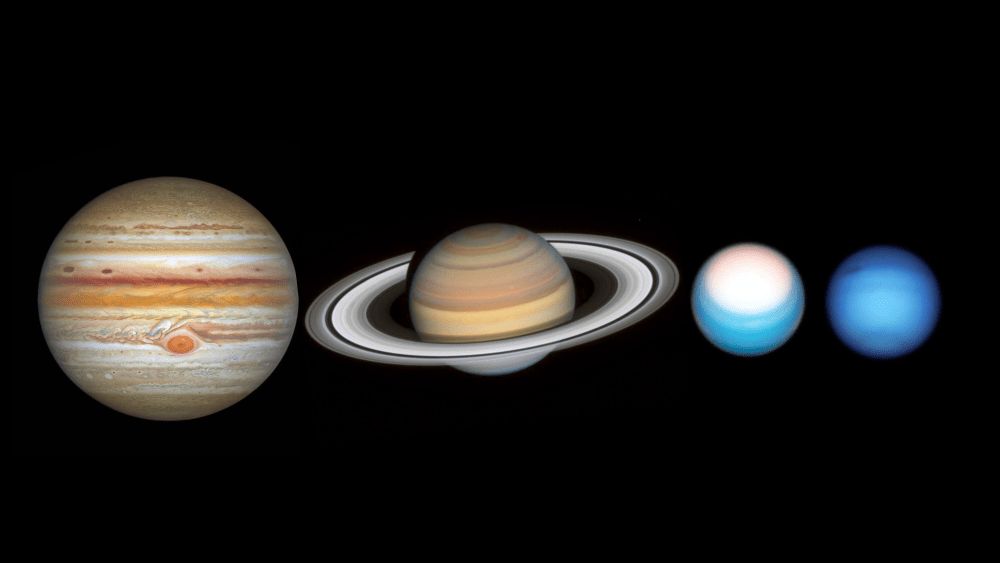If we had to rely solely on spacecraft to learn about the outer planets, we wouldn’t be making great progress. It takes a massive effort to get a spacecraft to the outer Solar System. But thanks to the Hubble Space Telescope, we can keep tabs on the gas giants without leaving Earth’s orbit.
NASA’s Outer Planet Atmospheres Legacy (OPAL) program keeps an eye on the outer planets to monitor changes in their atmospheres. Changes on Jupiter, Saturn, Uranus, and Neptune take place on timescales of years and decades—or longer—so Hubble checks in yearly to see how the gas/ice giants are doing. It gives scientists a long baseline of data. Each year OPAL captures images of the outer planets, and OPAL is slated to continue until either Hubble itself is no longer operational, or until Hubble’s WFC3/UVIS camera is no longer functioning.
Jupiter
Even people who don’t follow astronomy closely know that Jupiter is a big ball of gas with a visually stunning and ever-changing atmosphere. (Don’t they?) Jupiter’s Great Red Spot (GRS) even has its own Wikipedia page. This year’s Hubble image of Jupiter puts the planet’s mesmerizing atmosphere on full display.

In this year’s image, the colour of the planet’s equatorial zone caught the OPAL team’s interest. It now has a deep orange hue which is unusual. The region is usually white or yellowish, and though it’s departed from that scheme recently, the deep orange is still a surprise.
Most of what’s visible in the upper atmosphere is ammonia. Dark bands in Jupiter’s atmosphere are called belts, while lighter bands are called zones. The zones are colder than the belts and are associated with upwellings. Belts are descending gas. The lighter colour of the zones is because of ammonia ice, while the cause of the darker belts is uncertain.

The 2021 image shows several elongated reddish storm cells that scientists call “barges.” They’re actually cyclonic vortices, which means they’re rotating counterclockwise. There are also several smaller cyclonic storms south of the equator and the GRS.

Saturn
No other planet has an atmosphere as visually interesting as Jupiter. But Saturn has its beautiful rings, and those rings have their own Wikipedia page, just like Saturn’s GRS.

Though not as pronounced as Jupiter’s, Saturn’s bands are also ever-changing and not wholly understood. They signify powerful storms with wind speeds reaching 1800 km/hour at the equator. Though not clear in OPAL images, Saturn also hosts a long-lasting hexagonal shaped storm at its north pole. (The hexagonal storm also has its own Wikipedia page.)

Saturn’s rings feature prominently in every image of Saturn. In 1655, Christian Huygens was the first to identify them as a disk surrounding the planet. They’re largely made of water ice, ranging in size from tiny grains to boulders. The exact mechanism that formed them is not wholly understood, and astronomers are also uncertain of their age. Some evidence suggests they’re from the Solar System’s early days, while data from Cassini suggests they’re relatively young, between 10 million and 100 million years old.

Uranus
Uranus is an awfully long ways away and Hubble images aren’t as sharp as they are for Jupiter and Saturn. Unlike Jupiter and Saturn, which are gas giants, Uranus (and Neptune) are ice giants. But it’s still possible to track changes in the planet’s upper atmosphere.

This image captures springtime in Uranus’ northern hemisphere. Scientists think that increased UV radiation from the Sun is brightening the polar region, though they’re not exactly certain why. The ice giants have more methane than the gas giants, and the increased UV might be making the methane more opaque. Or there could be something else happening with aerosol particles in the atmosphere.
One thing is constant over the last several years of OPAL observations. Even as the atmospheric hood brightens, the sharp southernmost boundary stays at the same latitude. It’s possible that a jetstream enforces that barrier.
Uranus is a strange planet because it rotates at an almost 90 degree angle relative to its orbit around the Sun. That means that the planet has very strange seasons compared to Earth. Its orbit takes 84 Earth years to complete, so each season is 21 years long. Uranus, unlike other planets, has a nearly circular orbit around the Sun, so its seasons are entirely due to the planet’s tilt.
Neptune
Neptune has its own spot, though its dark rather than red. (The spot also has its own Wikipedia page.) Astronomers have been keeping an eye on it since 1989. Actually, it’s not one dark spot, but a recurring series of storms that disappears and reforms every few years. Contrast that with Jupiter’s GRS, which has been around for hundreds of years.

The OPAL team has been watching Neptune’s dark spot for years now. Previous images showed the dark spot, which is a storm the size of the Atlantic Ocean, moving south toward certain destruction. Then in 2020, the OPAL image showed the spot reversing course northward. The Hubble has watched storms form and dissipate on Neptune for 30 years, but it’s never seen this before. This is the fourth dark spot storm that Hubble has seen since 1993, and all prior storms followed a more-or-less straight path to the equator, where they dissipated.

Like its sister Uranus, Neptune is also an ice giant rather than a gas giant. The greater percentage of methane in the atmosphere gives it its blue appearance.
More:
- Universe Today: Stare Straight Down Into a Giant Storm on Jupiter
- Universe Today: Stunning Image Shows How Saturn’s Tiny Moon Sculpts the Planet’s Rings
- Universe Today: Uranus’ Moons are Surprisingly Similar to Dwarf Planets in the Kuiper Belt
- Universe Today: NASA Thinks it’s Time to Return to Neptune With its Trident Mission


The first paragraph about Saturn concludes with, “just like Saturn’s GRS”. I believe it should read, “just like Jupiter’s GRS”.